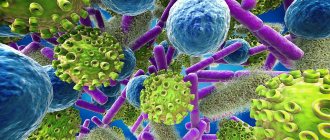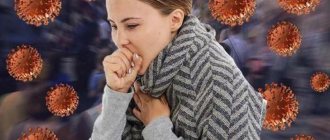In medieval medicine, viruses were all the most unpleasant and dangerous things, including poisons, spoiled foods and various impurities. In ancient stories about careless politicians, it was mentioned that they poured viruses - the poison of their bile - onto those around them. There are still politicians who are dissatisfied with their voters, but these days the term “virus” is still most often used in the literal rather than figurative sense.
In total, about six thousand viruses are known.i The discovery of new species is avalanche-like and continuously growing every year, including due to the fact that new diagnostic methods are being improved; humanity is becoming aware of what was inaccessible just a few years ago. Perhaps the hour is not far off when scientists will find effective methods of protection against all viruses that cause diseases. And our descendants will never face epidemics and pandemics. In the meantime, viral diseases occupy one of the first places among all human diseases. And you need to be able to fight them.
- Types of viral infections Respiratory viruses
- Gastrointestinal infections
- Infectious diseases of the skin and mucous membranes
- Infectious liver diseases
- Treatment of papillomavirus infection
Major viral infections
A viral infection is a disease that occurs when pathogenic viral particles enter the body. Viruses hijack normal living cells in the body. They use these cells to replicate and multiply, ultimately destroying the host cell - this is what causes the symptoms of a viral infection. It is important to understand the differences between viral and bacterial infections. Unlike bacterial infections, which can be treated with antibiotics, viral infections are not as easy to treat. Many, such as ARVI, run their course and the body recovers on its own, while others, such as HIV, do not.
Viral diseases are extremely common infections. There are many types of pathogens that cause a wide variety of viral diseases. The most common type of viral illness is the common cold, caused by a viral infection of the upper respiratory tract (nose and throat). Other common viral diseases:
- chicken pox;
- flu;
- herpes;
- human immunodeficiency virus (HIV/AIDS);
- human papillomavirus (HPV);
- Infectious mononucleosis;
- mumps, measles and rubella;
- shingles;
- viral gastroenteritis (stomach flu);
- viral hepatitis;
- viral meningitis;
- viral pneumonia.
Viral infections are highly contagious and are transmitted from person to person when the virus enters the body and begins to multiply. The source is a sick person (animal) or carriers. Common routes and mechanisms of human-to-human transmission of viruses include:
- inhalation of airborne droplets contaminated with the virus;
- eating or drinking water contaminated with the virus;
- sexual contact with a person infected with a sexually transmitted virus;
- indirect person-to-person transmission by a viral host such as a mosquito, tick, or field mouse;
- touching surfaces or body fluids contaminated with the virus.
Viral diseases vary in their development and course and cause a wide range of symptoms that vary in nature and severity depending on the specific cause of the viral infection and other factors, including the person's age and general health.
Viral diseases cannot be treated with antibiotics, which can only cure bacterial diseases and infections. However, the most common forms of viral infection - ARVI and influenza - go away on their own in relatively healthy people. Source: Influenza and acute respiratory viral infections. Selkov S.A. Infection and immunity, 2021. p. 216. This means that common species cause illness for a certain period of time, then the effects of the viral infection subside, all symptoms disappear as the immune system attacks the virus and the body recovers.
The dangers of seasonal flu
Every year, about 4 million people across the planet fall ill with the flu. Children get sick much more often than adults. 10% of those infected die due to complications. The danger is not the virus itself, but the possible consequences. Coronavirus can develop into severe pneumonia.
Viral pneumonia develops at a rapid pace, completely affecting the bronchi. Since the disease affects two lungs at once, the patient experiences severe respiratory failure. The following complications are possible with influenza: bronchitis, tracheitis, otitis media, myocarditis, neuralgia.
Despite the likelihood of complications, in many cases the disease is mild. Complications are possible with weak immunity, which is unable to overcome the infection. With the flu, chronic pathologies most often worsen.
Viral infection: main symptoms of the disease
Symptoms of viral diseases vary depending on the specific type, the characteristics of the virus causing the infection, the area of the body affected, the age, medical history of the patient and other factors, the initial condition of the viral infection. Symptoms of viral diseases can affect almost any area of the body or body system. These may include:
- flu-like symptoms (fatigue, fever, sore throat, headache, cough, aches and pains);
- gastrointestinal disorders such as diarrhea, nausea and vomiting;
- irritability;
- malaise;
- rash;
- sneezing;
- nasal congestion, runny nose, or postnasal drip;
- swollen lymph nodes;
- inflammation, swelling of the tonsils;
- unexplained weight loss.
In infants, the pattern of viral infection may also include:
- protrusion of the fontanel on the top of the head;
- feeding difficulties;
- constant crying or restlessness;
- excessive sleepiness.
Questions for test control.
1. What dose of sumamed is used to treat patients with intrauterine chlamydia:
- a. 2 mg/kg weight
- b. 3 mg/kg weight
- c. 10 and 5 mg/kg body weight
- d. 15 mg/kg weight
2. Which of the following clinical signs is characteristic of children with Epstein-Barr disease?
- a. Diarrhea
- b. Constipation
- c. Sore throat + lymphadenitis
- d. Flatulence
3. Select an effective antiviral drug to treat the active phase of cytomegalovirus infection:
- a. Zovirax
- b. Neovir
- c. Ganciclovir
- d. Arbidol
4. Select an effective drug to treat the reactivation phase of Epstein-Barr viral infection:
- a. Foscarnet
- b. Arbidol
- c. Valaciclovir
- d. Ganciclovir
5. What period of treatment is recommended for patients with a generalized form of congenital toxoplasmosis?
- a. 1-2 months
- b. 3 months
- c. 6 months
- d. 12 months
6. At what age is it recommended to start preventive vaccinations for children with a generalized intrauterine form of cytomegalovirus infection?
- a. At 3 months
- b. At 6 months
- c. After 1 year
- d. After 2 years
7. Which antibiotic is the drug of choice for a patient with a generalized form of recurrent yersinia infection?
- a. Erythromycin
- b. Amoxicillin
- c. Gentamicin
- d. Lincomycin
8. What immunomodulatory drugs are used in patients with mixed herpesvirus infections?
- a. Viferon
- b. Lycopid
- c. Polyoxidonium
- d. All listed
9. Indicate possible ways of infection of newborns with cytomegaly virus in the perinatal period of their life:
- a. Infected maternal birth canal
- b. Breast milk
- c. Transfusion of blood contaminated with cytomegalovirus
- d. All listed
10. Which of the listed biochemical markers remain longer during the treatment of cytomegalovirus hepatitis in children?
- a. Markers of cytolysis
- b. Markers of cholestasis
- c. Indicators of pigment metabolism (bilirubin)
- d. Lipid metabolism indicators
Serious signs that may indicate life-threatening complications
In some cases, it is necessary to strictly control how the infection manifests itself. Seek medical attention immediately if you experience any of the following symptoms:
- change in orientation in time, space or level of consciousness;
- chest pain;
- deep, wet chest cough producing yellow, green, or brownish sputum;
- high temperature (above 39 degrees);
- lethargy or lethargy;
- convulsions;
- shortness of breath, wheezing, or difficulty breathing;
- stiff neck muscles;
- yellowing of the skin and whites of the eyes (jaundice).
Diagnostic methods
Most acute respiratory viral infections and influenza during the epidemic season are diagnosed clinically, taking into account the characteristics of the symptoms, the severity of the disease and the timing of the development of the disease (incubation period). Depending on how long the incubation period lasts - from the moment of contact with the patient to the first signs of the disease, the type of ARVI can be clarified.
In some cases, certain tests can help - blood tests, PCR tests, antibody studies. Viral infections have specific laboratory diagnostic features; they are characterized by changes in blood parameters. Additionally, the doctor can decide how to identify and distinguish specific types of viruses. For example, when infected with COVID-19, it is necessary to perform a rapid test for the presence of the virus, and during the recovery stage, it is necessary to determine the level of antibodies. Source: Improving the diagnosis of herpes viral infections. Vasiliev A.N., Fedorova N.E., Klimova R.R., Adieva A.A. Clinical laboratory diagnostics, 2012. p. 52-55.
Clinical picture of scarlet fever
The incubation period for scarlet fever usually lasts 2-3 days, with a maximum of 7 days.
At the beginning of the disease, symptoms of intoxication appear, redness of the mucous membrane of the pharynx and tonsils, a pinpoint small rash (enanthema) on the soft palate, and tonsillitis gradually develops.
This is followed by a period of rashes: a pinpoint bright pink rash appears on the skin of the torso, the flexor surface of the arms, and the inner surface of the legs. The rash thickens in the natural folds of the skin and is located against a background of redness. The rash associated with scarlet fever is characterized by the absence of a “spilling” effect. The skin rash can be hemorrhagic (pinpoint hemorrhages) or small papular (small tubercles). The rash is absent in the area of the nasolabial triangle - this is one of the diagnostic signs of scarlet fever (Filatov syndrome). Another characteristic symptom is the bright crimson color of the tongue.
By the 4th day of illness, the rash fades and becomes pale pink. From the second week of the disease, a period of recovery (convalescence) begins, during which lamellar peeling appears on the palms and soles.
Complications of scarlet fever - otitis media, sinusitis, myocarditis, nephritis.
To laboratory confirm the diagnosis of scarlet fever, serological methods are used - identifying specific antibodies Ig M, Ig G in the blood and increasing the level of antibodies to streptolysin O.
- Anti-streptolysin O.
The causative agent of scarlet fever can be identified by the cultural method - when sowing on artificial nutrient media.
- Microbiological (culture) test for beta-hemolytic streptococcus group A (Streptococcus group A, S.pyogenes).
- Microbiological (culture) test for beta-hemolytic streptococcus group A (Streptococcus group A, S.pyogenes) with determination of sensitivity to antimicrobial drugs.
Mumps is an acute infectious disease. Mumps is manifested by fever, symptoms of intoxication, inflammation of the salivary glands, damage to other glandular organs and the nervous system.
Mumps is transmitted by airborne droplets and household contact. The source of infection is a sick person.
The causative agent of mumps is the Mumps rubulavirus virus, which contains RNA and belongs to the paramyxovirus family.
The incubation period lasts from 11 to 21 days, usually 15 days. The onset of the disease is acute, with an increase in temperature, symptoms of intoxication, swelling and pain in the parotid gland appear. It is customary to distinguish between intoxication syndrome and glandular organ damage syndrome.
Intoxication syndrome - headache, loss of appetite, weakness, fever up to 38-40°C.
Glandular organ damage syndrome. The parotid salivary glands increase in size, pain appears, and swelling of the surrounding subcutaneous fat is possible. The face becomes round, the neck appears thicker. The popular name for mumps, mumps, was given to the disease for the characteristic appearance of the patient. The atypical form of mumps can occur without damage to the salivary glands.
Over the course of several days, other salivary glands – sublingual, submandibular – may also become involved in the pathological process.
Damage to the pancreas - occurs in 20-40% of cases, manifested by symptoms of pancreatitis - abdominal pain, nausea, vomiting, constipation. Damage to the gonads in boys (orchitis) develops acutely, on the 6-7th day of illness, as a rule, the process is one-sided. Characterized by a rise in temperature, pain in the testicle, which can spread to the groin area, to the inner surface of the thigh. The testicle increases in size and becomes dense in consistency. Symptoms last 3-5 days and disappear completely within 7-10 days.
Damage to the female reproductive glands (oophoritis) in girls is quite rare and can occur during puberty.
Syndrome of damage to the central and peripheral nervous system is also a rare phenomenon, most often occurring in children aged 3-9 years. Manifested by severe weakness, drowsiness, meningeal symptoms, convulsions, impaired consciousness.
Complications of mumps include arthritis, nephritis, inflammation of the cranial nerves (myelitis), meningoencephalitis, and encephalitis. When diagnosing mumps, special attention is paid to the clinical picture: swelling of the parotid glands, pain when chewing, fever, intoxication. Diagnostically significant are Murson's symptom (redness and inflammatory reaction of the mucous membrane around the duct of the inflamed parotid gland); Filatov's symptom (pain when pressing behind the earlobe). Laboratory diagnostics.
To detect pathogen RNA, a molecular biological method is used - polymerase chain reaction (PCR). A serological method is also used - determination of specific antibodies Ig M, Ig G in blood serum:
- Mumps virus (Mumps), qualitative determination of IgG antibodies.
- Mumps virus (Mumps), qualitative determination of IgM class antibodies.
With pancreatitis, a biochemical blood test reveals an increase in the amylase enzyme.
Treatment of viral infection in adults
Treatment for viral infections depends on the specific virus and other factors. General treatment measures are aimed at relieving symptoms so that a person can rest, maintain their strength, and recover without developing complications. The doctor determines how to treat infections.
Common medications and non-drug treatments for viral infections include:
- antipyretic, non-steroidal anti-inflammatory drugs for fever, body aches and pain;
- taking extra warm liquid;
- additional rest and sleep;
- proper nutrition.
It is important to know that antibiotics are not indicated for viral infections; they are applicable only when microbial complications develop or threaten to develop.
Depending on the type of viral infection and the presence of complications, a wide range of other treatments may be needed. For example, a human papillomavirus (HPV) infection that leads to cervical dysplasia can be treated by surgically removing abnormal cells on a woman's cervix.
In some cases, certain medications may be prescribed to treat viral diseases:
- antiretroviral drugs, which prevent HIV from reproducing, which slows the spread of HIV in the body;
- antiviral drugs that minimize the severity and duration of some viral infections such as influenza and shingles, especially in people at high risk for serious complications. For example, the drugs Oseltamivir and Zanamivir may be prescribed for some cases of influenza. These medications are not suitable for everyone who has the flu.
Preventive measures
You can prevent the flu if you properly influence the source of infection. Even if a person has already had the flu, his body still remains susceptible. You can neutralize the infection without becoming infected with it through vaccination.
If you add up all the cases of influenza, a person will be sick for an average of one year in his or her entire life. To strengthen your immunity, you should get vaccinated, which will protect you from the virus in 93%. In the remaining 7%, ARVI may occur in a mild form.
The vaccine consists of viral particles in a split form. Less commonly, it is created from interactive whole viruses. This is the vaccine that is actively used today. Fragments of the virus penetrate the human body, which eliminates the possibility of infection with ARVI.
Vaccine protection has the only disadvantage - the effect lasts for a certain time. That is why vaccination should be done once a year.
Possible complications after viral infections
In some cases, the illnesses can lead to serious, possibly life-threatening complications from a viral infection, such as dehydration, bacterial pneumonia, and other secondary bacterial infections. This is especially likely in people at risk of complications. These include those with chronic illness, suppressed or weakened immune systems, infants and the elderlySource: ACUTE RESPIRATORY VIRAL INFECTIONS AND THE HEART. Kirichenko A.A. Consilium Medicum, 2021. p. 22-27. In addition, some types of sexually transmitted viral infections, such as HIV/AIDS and HPV, are themselves dangerous and can lead to serious complications and death.
Prevention and protection measures
Viruses spread in different ways, depending on their classification and characteristics. Hepatitis C, a liver disease, is transmitted through body fluids. On the other hand, the flu can be spread by contact with the virus left on an object, such as a phone, or through droplets in the air if someone with the flu sneezes or coughs in front of you. Not all viral infections can be prevented, but you can reduce your risk of contracting the virus in several ways:
- regularly vaccinate against viral infections;
- wash your hands frequently;
- avoid contact with sick people;
- Do not give personal items to anyone (toothbrushes, razors, manicure accessories).
Article sources:
- Laboratory diagnosis of congenital viral infections. Nisevich L.L., Bakhmut E.V., Ashirova A.A., Medzhidova A.A., Kushch A.A., Konopleva T.N., Talalaev A.G., Kask L.N., Parsegova T. S.S., Tumanova E.L. Children's infections, 2006. p. 12-18
- A new look at latent viral infection. Filatov F.P., Shargunov A.V., Blinov V.M. Hematology and Transfusiology, 2014. p. 28
- Improving the diagnosis of herpes viral infections. Vasiliev A.N., Fedorova N.E., Klimova R.R., Adieva A.A. Clinical laboratory diagnostics, 2012. p. 52-55
- Features of immunosuppression in viral infections. Churina E.G., Urazova O.I., Novitsky V.V., Naslednikova I.O., Voronkova O.V., Slepicheva N.R. Bulletin of Siberian Medicine, 2009. p. 112-118
- Influenza and acute respiratory viral infections. Selkov S.A. Infection and immunity, 2021. p. 216
- ACUTE RESPIRATORY VIRAL INFECTIONS AND THE HEART. Kirichenko A.A. Consilium Medicum, 2021. p. 22-27
Who needs the vaccine
Every person needs vaccination, even those with the strongest immunity and who are practically never sick. Even if the cold is mild or completely asymptomatic, the person will be a carrier of the infection and will be able to infect other people with weak immune systems. Therefore, vaccination will protect not only yourself, but also those around you.
The following categories of people especially need to prevent influenza through vaccination:
- women in position regardless of trimester;
- children from six months to 5 years;
- aged people;
- adults with chronic pathologies;
- people suffering from obesity or diabetes;
- people with diseases of the nervous system;
- doctors and medical personnel in contact with patients;
- people whose profession involves contact with numerous people.
There is a chance of becoming infected by taking hormonal-based anti-inflammatory drugs.









